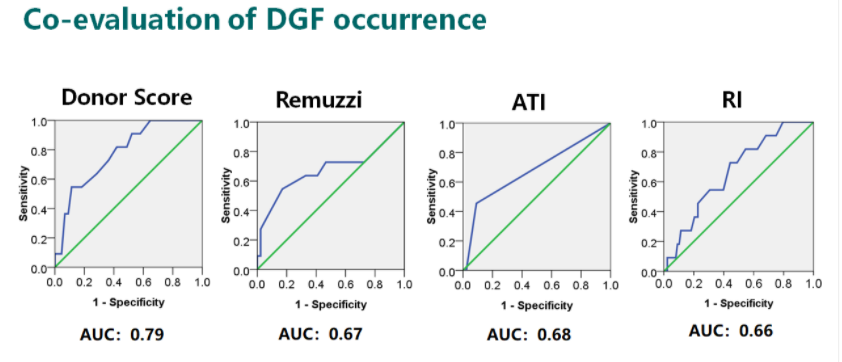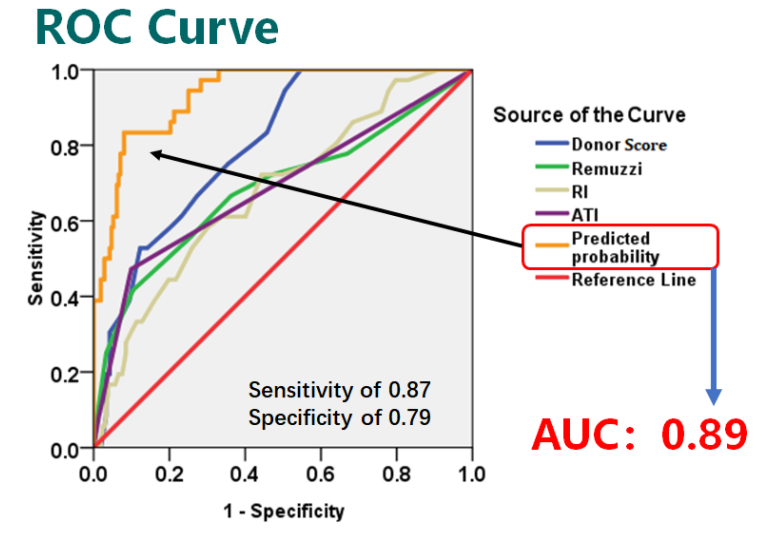Comprehensive assessment of deceased donor kidneys with clinical characteristics, pre-implant biopsy histopathology and hypothermic mechanical perfusion parameters is highly predictive of delayed graft function
Jin Zheng1, Wujun Xue1.
1Department of Kidney Transplant, The First Affiliated Hospital of Xi'an Jiaotong University, Xi'an, People's Republic of China
Department of Kidney Transplant, The First Hospital of Xi'an Jiaotong University.
Background: Aside from a living relative, donation after an individual’s death has become the only source of transplantable organs in China since 2015, which only minimally alleviates the shortage of organ sources for ill patients. Due to the current high demand for transplant tissue, an increasing proportion of kidney donors are considered extended criteria donors (ECD), which results in a higher incidence of delayed graft function (DGF) in organ recipients. Therefore, it is important to more fully investigate the risk factors that lead to DGF, and establish a comprehensive prediction system to better assess donor kidney quality before transplantation in order to minimize any delay in renal function recovery.
Methods: A total of 333 Donation after Cardiac Death (DCD) kidney transplant recipients were included in this retrospective study. Both univariate and multivariate analyses were used to analyze the correlation between donor scores, pre-implant pathology scores, and hypothermic mechanical perfusion (HMP) variables with DGF occurrence. Receiver operating characteristic (ROC) curves were used to analyze the predictive value of variables on DGF posttransplant. This cohort study was approved by the Institutional Review Board/Ethics of the First Affiliated Hospital of Xi’an Jiaotong University and was conducted in accordance with the principles of Declaration of Helsinki.
Results: The donor clinical scores, kidney histopathologic Remuzzi scores and HMP parameters (flow and resistance index) were all correlated. 46 recipients developed DGF postoperatively, with an incidence of 13.8% (46/333). Multivariate logistic regression analysis of the kidney transplants revealed that the independent risk factors of DGF occurrence post-transplantation included donor score (OR=1.12, 95% CI: 1.06-1.19, p<0.001), Remuzzi score (OR=1.21, 95% CI: 1.02-1.43, p=0.029) and acute tubular injury (ATI) score (OR=4.72, 95% CI: 2.32-9.60, p<0.001). Prediction of DGF with receiver operating characteristic curve (ROC) showed that the area under the curve (AUC) of donor score, Remuzzi score, ATI and HMP resistance index were all lower than 0.80.

However, AUC was increased to 0.89 when all variables were considered together.

Conclusions: Our analysis shows that the combination of donor clinical information, kidney pre-implant histopathology and HMP parameters provide a more accurate prediction of DGF occurrence post-transplantation than any of the measures alone. These findings have the potential to increase the occurrence of successful kidney transplants with fewer complications.
We very much appreciate the help of Mr Jian Yang and Miss Fan Gao who helped analyze data and revise the manuscript..
There are no comments yet...
